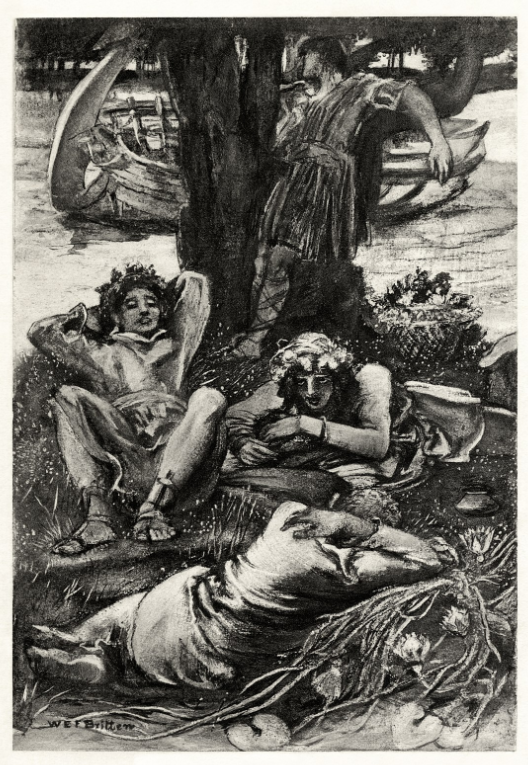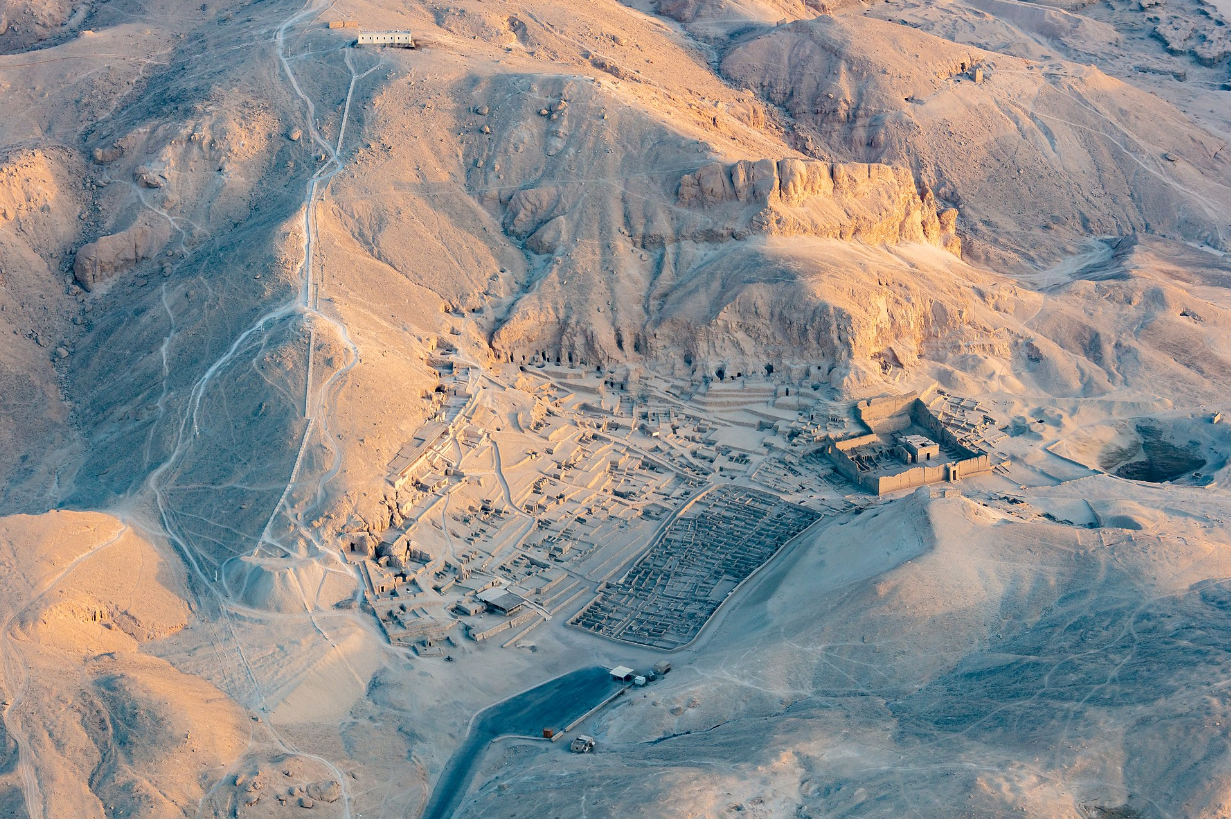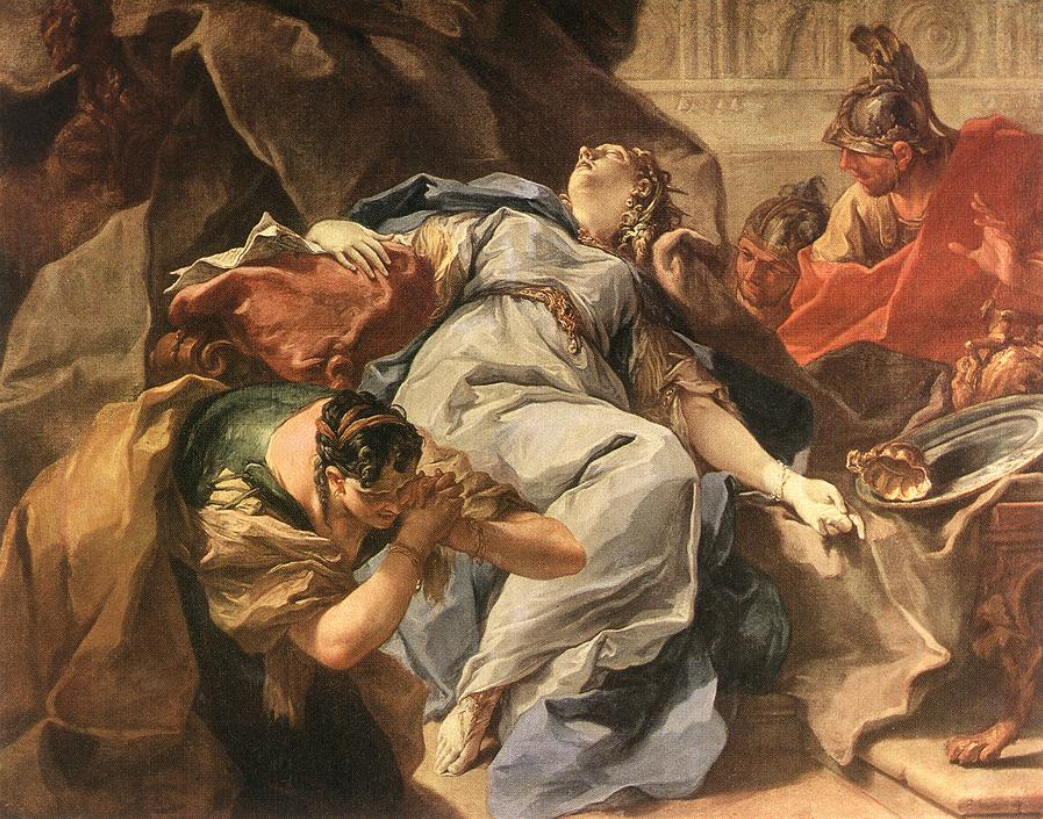Imaginary Sonnets
Daniel Galef's first book Imaginary Sonnets is a series of persona poems each from the point of view of a different historical, literary, or mythological figure (ripped off from inspired by a collection by the Victorian poet Eugene Lee-Hamilton) - including a lot of Classical figures, such as Penelope, Cassandra, Rhinthon of Syracuse, Zaleucus the Epizephyrean, Nossis, Alcibiades, Parmenides, Gnaeus Calpurnius Piso, and Emperor Tiberius.
Of the three poems below, the third ("Sophonisba") is in the collection, while the other two ("Lotophage" and "Hay") are new.
"The Lotos-Eaters" by W. E. F. Britten.
A Lotophage to the Crewmen of Ulysses
Eat, weary friends. There’s always more. When towards
the setting sun you sailed, you slipped the noose
of soil and sweat, spurned ploughs to take up swords.
This is no battlefield—unfurrowed sand
demands no sacrifice. The story fades
of toil and carnage. Were these wooden flags
your pikes? What king is blazoned on these rags?
“Lay down thy sword!” But stay the next command,
to beat them into something of more use.
Spurn both! Lay down your sword and ploughshare each—
no need to delve for blood, or stab the dust!
Like Ajax, dig your last, bury your blades
beneath the earth and sea, and let them rust,
and crumble into sand beneath the beach.
After Odyssey Book IX and the /r/antiwork internet forum
* In Book IX of the Odyssey the crew encounters the Island of the Lotophagi (or Lotus-Eaters). The mysterious tribe, which seems not to work or farm, gives lotus to the visitors. Some of the weary crew eat the food offered by the natives, and those who do are struck with a sort of apathy: They do not lose their memory, but do not return to the ship and seem to have lost all desire to return home to their lands and their families. Scholars have long speculated about what real flower or fruit (if any) the lotos may have been, including theories about psychoactive or opiate plants, or whether it was purely symbolic. The website mentioned, R/AntiWork, was a controversial anticapitalist internet forum that ranged from, at best, criticizing exploitative labor practices to, at worst, bizarre conspiracy theories and utopian fantasizing.
Deir el-Medina (previously Set-Maat), Luxor, Egypt
The Workmen Qenna and Hay to the Vizier To
The Eye of Ra, unblinking, bakes our backs
like bricks. The sand grains grind us down to bones.
The work songs turn to grunts, then wails and moans.
And now the ration’s late—all fifty sacks.
One grain of sand alone has never burned
my flesh. One spark can’t keep the barracks warm,
but a billion grains of sand become a storm.
This is the Place of Truth. One truth we’ve learned:
that numbers add to numbers (staggering stuff),
blocks stacked upon blocks reach to the sky,
digits sum to cubits, spans, and rods,
like lost time builds beneath Ra’s sailing Eye
and even feathers, if there are enough,
might tip the scales, and force the hands of gods.
After the records of Amennakhte in papyrus TM 139434
* The records of the scribe Ammenakhte of the Secret Tomb and his colleagues are some of the earliest primary sources we have for Ancient Egyptian labor relations. Set-Maat was a workers' village across the Nile from Thebes, in the Valley of the Kings, housing the builders of the Necropolis. In hundreds of papyri from the well-preserved settlement we have record of day-to-day minutiae in the lives of the workers and their families. In one papyrus, TM139434 (also known as the "Turin Strike Papyrus"), Amennakht records a dispute between workforce and management in the twenty-ninth year of the reign of Rameses III: the rations are late (something that has been an issue before) and representatives of the workers approach the Vizier to inform him that they have laid down their tools and work will not commence until the Pharaoh's end of the bargain is held up. An emissary is sent to Thebes, and the rations are delivered. This is the first recorded strike in human history.
'Death of Sophonisba'', Oil on canvas, 165 x 214 cm, Pushkin Museum, Moscow
Sophonisba to Gaia
How fickle our allegiances! How feigned
our feints and fancies. Why am I at fault
when Syphax couldn’t snivel and exalt
the Glory That Is Rome and not sound pained?
My final freedom cannot be constrained;
I’ll cruise the crystal spheres of Heaven’s vault
while widow Dido’s kingdom’s sown with salt.
What form would Earth appear, this perch attained?
A sailor’s map, faint shapes of sand-drawn shores?
A Roman Triumph, empty in its heart?
A nameless fray, no sanity, no start?
Unlabeled land, with life in every part?
And, as my shade through seas of starlight soars,
could I tell the earth the Romans rule from yours?
After Livy, Ab urbe condita Books xxix and xxx, and Cicero, De re publica Book vi, ‘Scipio’s Dream’
* Sophonisba was a Carthaginian noble and the wife of, first, King Syphax and, later, King Masinissa, who fought on opposite sides of the Second Punic War, which ended with Rome (and the confederated tribes ruled by Masinissa) defeating Carthage (and other Numidian tribes, including Syphax's). Fearing Sophonisba would make Masinissa turn against Rome just as Syphax had, the Roman general Scipio demanded her capture. Faced with the prospect of being paraded through Rome as war spoils as part of a Triumphal procession, she chose to commit suicide by drinking poison, a subject extremely popular with Renaissance painters (many purported portaits of Sophonisba are impossible to distinguish from portraits of Queen Artemisia of Caria, or of the biblical Judith). The poem also incorporates elements from a philosophical parable of Cicero's in De Re Publica, called "Scipio's Dream," in which the ghost of General Scipio appears to one of his descendants and takes him on a tour of the cosmos, rising high above all human perspective.




